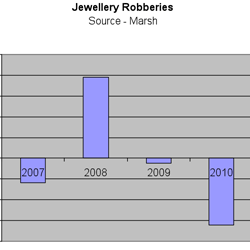|
News
Articles from EDUCATION / TRAINING (185 Articles)

The last bar shows a sharp decrease in 2010's jewellery robberies
Jewellery robberies drop
Posted September 07, 2010 | By Sonia Nair
Jewellery robberies have plummeted more than 50% so far this year, painting an encouraging picture for independent jewellery retailers.
Speaking at last week’s International Jewellery Fair in Sydney, JAA chief executive Ian Hadassin said, “As far as jewellery robberies go, 2010 has been an excellent year.”
Last year showed a sharp decrease in jewellery robberies, according to figures from insurance firm Marsh, but 2010 has proved even better, with more than a 50% drop in comparison to 2009.
Despite the global financial crisis and a perceived decrease in overall jewellers, the State of the Industry talk at this year’s Sydney trade fair painted a fairly rosy picture of the jewellery industry.
Through an independent benchmarking survey revealed at the seminar, Nationwide managing director Colin Pocklington brought attention to the high growth rate from 2008 onwards – at exactly the time that the global recession hit.
“The $16 billion government handouts and $425 million retail sales that Pandora injected into the industry had a big, positive impact,” he explained.
Pocklington added that the strong Australian dollar had gone some way to mitigate the rising cost of gold and would insulate it against a possible US double-dip recession.
He also claimed that the 32% increase in the average Australian’s income had helped the jewellery sector, which has always traditionally been perceived as a non-essentials industry. More disposable income was good news for jewellers, Pocklington argued.
In terms of benchmarking, Pocklington calculated that figures collected by the Australian Taxation Office showed jewellers with sales of between $250,000 to $750,000 should be managing gross profits of between 49 per cent to 61 per cent while jewellers with sales of between $750,000 to $2,000,000 should be managing gross profits of between 46 per cent and 56 per cent.
However, in what was described as an “alarming” and unexplained statistic, figures from the Australian Bureau of Statistic (ABS) based on employment categories showed that the 5,000 people who used to call themselves jewellers has dropped to 2,200.
Pocklington said he couldn’t see signs of such an extreme reduction and attributed it to people reclassifying what their primary income source was.
Out of over 3,000 retail jewellery outlets, there are 1,436 independent stores, 826 chain stores 806 retail jewellers from buying groups.
In 2008, the ABS stopped collecting jewellery industry-specific sales data due to budget restrictions. Hadassin said the JAA planned to lobby the bureau to start collecting data again, so that jewellers would have something to benchmark themselves against.
Pocklington ended the Sydney trade fair session on a positive note, highlighting the fact that the last time the jewellery industry experienced a decrease in sales was in 1992-93. Although there had been a few flat years with little growth, he claimed he couldn’t see a decrease occurring again.
Note: The December issue of Jeweller will be dedicated to a comprehensive research project titled: State Of The Industry 2010. The Report will provide an exhaustive analysis of the Australian and New Zealand jewellery industries.
Image Gallery (2 Images)
|
|
Search for Education / Training
|
|